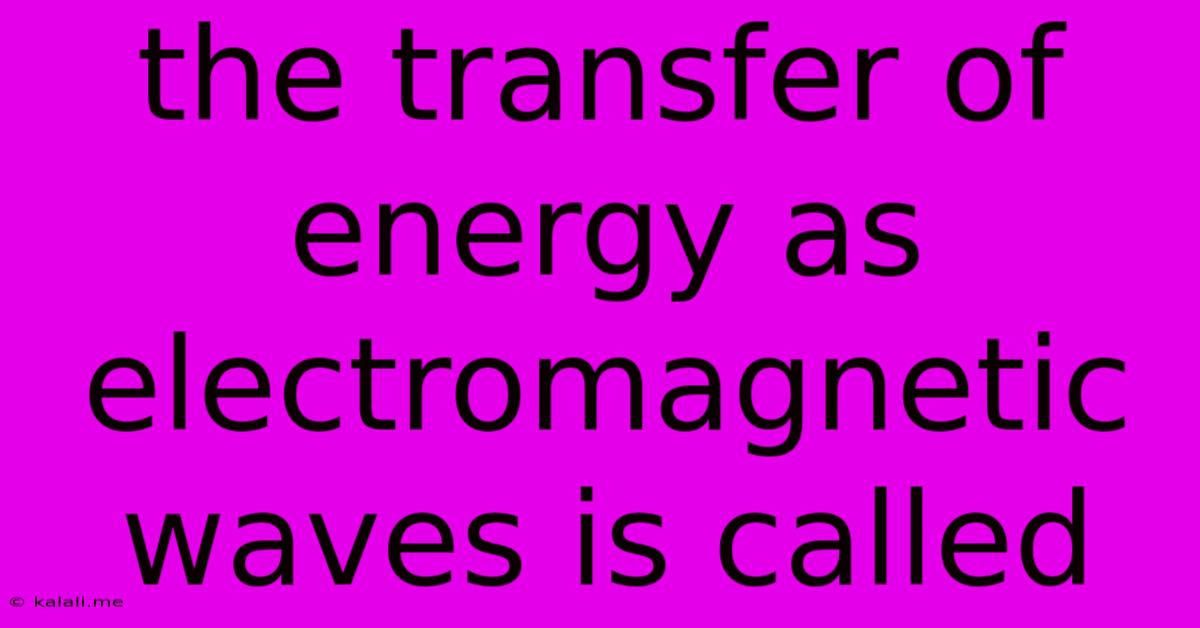The Transfer Of Energy As Electromagnetic Waves Is Called
Kalali
May 09, 2025 · 3 min read

Table of Contents
The Transfer of Energy as Electromagnetic Waves is Called: Radiation
The transfer of energy as electromagnetic waves is called radiation. This is a fundamental concept in physics, explaining how energy travels through space, even the vacuum of space, without the need for a medium. Understanding radiation is key to grasping many phenomena, from the warmth of the sun to the operation of Wi-Fi. This article will delve into the nature of electromagnetic radiation, its properties, and its diverse applications.
Electromagnetic radiation encompasses a wide spectrum of waves, all sharing the common characteristic of being self-propagating disturbances in electric and magnetic fields. These waves travel at the speed of light (approximately 3 x 10<sup>8</sup> m/s in a vacuum) and exhibit wave-particle duality, meaning they behave both as waves and as particles called photons.
The Electromagnetic Spectrum: A Diverse Family of Waves
The electromagnetic spectrum categorizes these waves based on their frequency and wavelength. From lowest frequency to highest, we have:
- Radio waves: Used in broadcasting, communication, and radar.
- Microwaves: Used in cooking, communication, and radar.
- Infrared (IR) radiation: Felt as heat, used in thermal imaging, and remote controls.
- Visible light: The only part of the spectrum visible to the human eye, encompassing the rainbow of colors.
- Ultraviolet (UV) radiation: Causes sunburns, used in sterilization, and contributes to vitamin D production.
- X-rays: Used in medical imaging and material analysis.
- Gamma rays: Highly energetic, used in cancer treatment and sterilization.
Each type of electromagnetic radiation interacts differently with matter, leading to a wide range of applications. For instance, radio waves can easily penetrate the atmosphere, making them ideal for long-distance communication, while X-rays can penetrate soft tissue but are absorbed by bones, making them useful in medical imaging.
How Radiation Transfers Energy
Electromagnetic radiation transfers energy through the oscillation of electric and magnetic fields. As these fields propagate, they exert forces on charged particles, causing them to accelerate and thus absorb energy. The amount of energy transferred depends on several factors including the intensity (amplitude) and frequency of the radiation. Higher frequency radiation (like gamma rays) carries more energy per photon than lower frequency radiation (like radio waves).
Examples of Radiation in Everyday Life
We encounter electromagnetic radiation constantly in our daily lives:
- Sunlight: The primary source of visible light and other forms of electromagnetic radiation on Earth. This radiation provides energy for photosynthesis and warms our planet.
- Heat from a fire: Infrared radiation emitted by a burning fire.
- Wi-Fi signals: Radio waves used for wireless internet connectivity.
- Medical imaging: X-rays and other forms of radiation used for diagnostics.
Conclusion: Understanding the Importance of Radiation
Understanding the transfer of energy as electromagnetic radiation is crucial for advancements in various fields, including medicine, communication, and energy production. Its diverse applications underscore its fundamental role in shaping our world and our technologies. Further research into the intricacies of electromagnetic radiation continues to reveal new possibilities and deepen our understanding of the universe. From the smallest atomic interactions to the vast expanses of space, radiation plays a pivotal role in the workings of the cosmos.
Latest Posts
Latest Posts
-
35 Celsius Equals What In Fahrenheit
May 10, 2025
-
What Is 114 Fahrenheit In Celsius
May 10, 2025
-
What Is 39 Inches In Cm
May 10, 2025
-
9 Oz Is Equal To How Many Cups
May 10, 2025
-
Organisms That Make Their Own Food Is Called
May 10, 2025
Related Post
Thank you for visiting our website which covers about The Transfer Of Energy As Electromagnetic Waves Is Called . We hope the information provided has been useful to you. Feel free to contact us if you have any questions or need further assistance. See you next time and don't miss to bookmark.